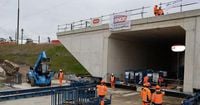In Saint-Louis, Haut-Rhin, the largest road project in southern Alsace is taking shape with the express installation of a new railway bridge over the RD105, set to be completed in just 120 hours. This ambitious initiative aims to double the lanes and alleviate congestion on a road that currently sees 30,000 vehicles daily.
Since February 19, 2024, the European Community of Alsace (CEA) has been spearheading this project, which includes the widening of the A35 motorway and the doubling of lanes on the RD105. The pressing need for this development became apparent, as the road's heavy traffic necessitated an effective solution to ease the flow.
After seven years of discussions with the SNCF (French National Railway Company), the CEA is finally realizing this crucial project. The installation of the two massive concrete blocks that will form the new railway bridge is scheduled from noon on Thursday, April 17, 2025, to noon on Tuesday, April 22, 2025. This construction is not just a routine task; it requires precision and careful planning.
Marie-Catherine Janin, project manager for the CEA, noted the challenges involved: "We chose to double the capacity of the RD105, but we faced a significant issue with the railway line. How do we allow these two new lanes to pass under such a major railway line?"
Indeed, the installation process involves lifting the railway tracks to accommodate the new bridge, which will temporarily reduce rail traffic. Maxime Jacquot, representing the SNCF's project management, explained the importance of the railway line: "This is a very important axis since it connects Mulhouse and Basel. Approximately 150 trains operate daily on this route."
To minimize disruptions, the railway company has skillfully managed to maintain the circulation of three out of four trains during the construction period by alternating track usage. This careful planning reflects the commitment to ensure that rail services remain operational while crucial infrastructure improvements are made.
The project is financed entirely by the CEA, with the SNCF managing the construction for a total cost of 17 million euros. The engineering feat involves moving two concrete frames weighing nearly 3,000 tons, supported by 26 jacks, and removing 7,000 cubic meters of earth for the necessary earthworks. The railway bridge itself will measure 8.5 meters in width and 4 meters in height.
Myriam Perez, the operations manager, described the concrete blocks as resembling "big Lego pieces made of concrete and steel." A staggering 2,800 tons of concrete and steel were required for their construction, in addition to the significant earthworks involved. Once the blocks are completed, they will be lifted and placed on the rails, moved slowly and meticulously under the supervision of surveyors. "We need to proceed carefully; the cruising speed is between fifteen and sixteen meters per hour," she added.
Once operational, this new railway bridge will allow for the doubling of lanes on the departmental road starting July 1, 2025, significantly improving traffic flow and reducing congestion.
Meanwhile, on a related note, French President Emmanuel Macron visited Strasbourg on April 19, 2025, to sign a three-year contract aimed at enhancing the European status of the Alsatian capital. During his visit, he addressed questions regarding the potential exit of Alsace from the Grand Est region. Macron emphasized, "We should not engage in grand institutional games." His comments were echoed by Dominique Faure, the Minister of Territorial Collectivities, who reiterated that the current map of the Grand Est would remain unchanged, dismissing any notions of redrawing regional boundaries.
Frédéric Bierry, president of the European Community of Alsace, has expressed strong support for the region's autonomy, but the government has made it clear that any significant changes to the administrative structure are off the table.
In the realm of transportation, the National Federation of Road Transport in Alsace organized a protest against the proposed heavy goods vehicle ecotax on April 17, 2025. The protest involved a slow-moving operation on the highway, converging on Colmar and the headquarters of the CEA. This demonstration reflects ongoing tensions regarding transportation policies in the region and the impact of taxation on local businesses.
As the railway bridge project progresses and regional discussions unfold, the residents of Alsace are keenly observing how these developments will shape their infrastructure and governance in the years to come.





